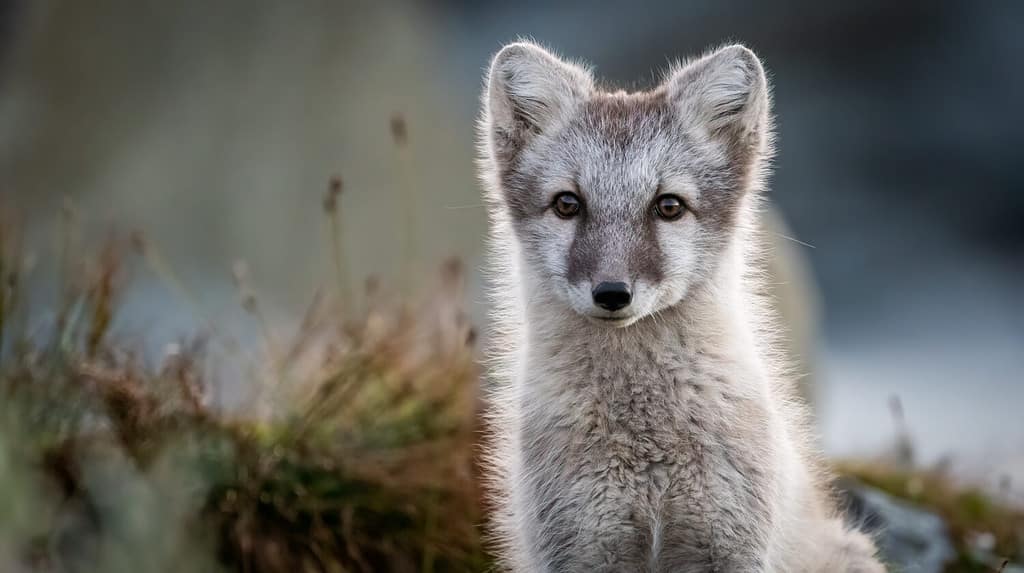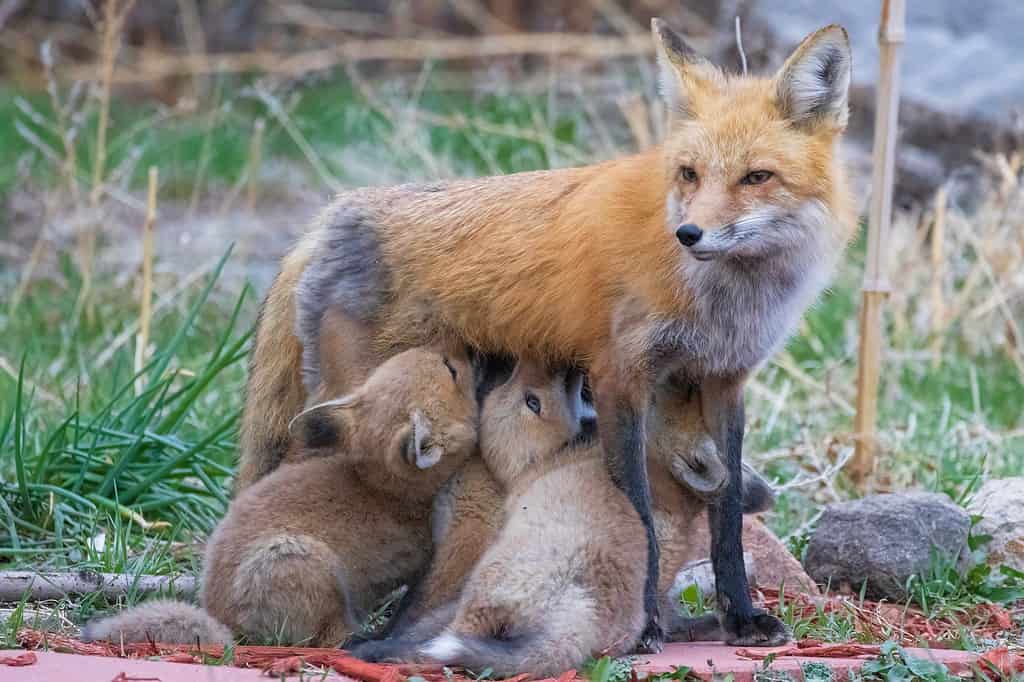Foxes remain a cute but potentially dangerous pest in Maryland. As part of the canine family, dog lovers alike — especially those with a Shiba Inu at home — have their hearts melted by these creatures as they wander into yards and even enclosed patios.
Because foxes have become accustomed to urban and suburban areas in Maryland, there’s a good chance you’ll happen across at least one while living, working, or vacationing in the Free State. Specifically, you’ll see more between the months of December and April, which covers both the mating season and the months in which new litters are born.
Discover the three different types of foxes you’ll come across in Maryland — and how to keep yourself and the fox safe when an unexpected encounter occurs.
3 Different Foxes in Maryland

Two foxes in Maryland fall into the “true fox” group.
©Rob Jansen/Shutterstock.com
While there are over 30 different species of officially-recognized foxes, only 12 different species belong to the “true fox” group of animals. Maryland is home to two — both of which are part of the “true fox” group.
Red Fox (Vulpes vulpes)

The red fox is one of the worst invasive species in the world.
©Sandra Standbridge/Shutterstock.com
The largest of the “true foxes,” the red fox remains Maryland’s most prevalent fox species. It is not in any concern of endangering and has been named among one of the world’s top 100 worst invasive species. Though they’re native to the northern hemisphere, they somehow made it all the way to Australia.
Part of the reason red foxes spread so vastly across the globe is their innate characteristic of adapting to new environments. red foxes are typically “urban foxes” as well — other species don’t fare as well in cities as the adaptable, clever, and quick red fox does.
Despite its name, the red fox’s fur isn’t always red. In fact, it has over 45 subspecies that range in color from tan to speckled gray.
Within Maryland, you’ll find red foxes throughout the state. They’re so widespread that the Department of Natural Resources can’t estimate their most concentrated populations. The habitats for red foxes are usually a mix of open fields, wetlands, and woodlots — but because they’re so adaptive, these foxes will stay with their family and move into suburban or urban places if led or attracted there.
Reproduction and Young
red foxes don’t reproduce year-round — they wait until the mating season in December when their reproductive organs double in size. While red foxes are usually monogamous, some pockets of fox populations indicate the opposite.
Litters of kits range between four and six pups. The kits, born blind, deaf, and toothless, rely on their mothers to protect them. The fathers or other barren mothers in the pack take care of the nursing mother in turn. If the mother dies before the kits can fend for themselves, the father will step in as the primary caretaker.
Gray Fox (Urocyon cinereoargenteus)

Gray foxes love to climbing up and through trees.
©iStock.com/johnpane
To the untrained eye, gray foxes may look similar to any other fox — they may even think it’s an oddly-colored red fox — but they do have distinct characteristics over other species in their genus.
Gray foxes have a more grizzled upper body, a black stripe down its thick neck, and a black-tipped tail. Furthermore, the claws of a gray fox are longer and more curved when compared to other species.
Though visitors and watchers won’t notice the size during an encounter, gray foxes also have differently-shaped skulls — their temporal ridges form a U-like shape.
Like red foxes, gray foxes have dealt with human interference in their habitats and deforestation by adapting to suburban living. However, these foxes become urban most notably in Florida, where wooded, brushy areas abound.
In Maryland, you may see a gray fox near brush-covered bluffs or climbing trees. While part of the Canidae family, gray foxes act more like cats than dogs when traipsing through the trees. They like to live in dense forests where they can clamber up the timber to hunt or evade a larger predator. As a rule, gray foxes don’t roam more than two to four miles from their den.
Gray foxes have also evolved to survive the threat and competition coyotes bring, meaning they’ll venture much closer to human civilization than coyotes (or for that matter bobcats) will.
Arctic Fox (Vulpes lagopus)

The Maryland Zoo recently lost its Artic fox, Timber.
©Cecilie Bergan Stuedal/Shutterstock.com
Arctic Foxes remain the only native land mammal to Iceland and are the only land mammal that travels as far north as the polar bear.
While Arctic Foxes aren’t native to Maryland — nor do they typically live in the state — the Maryland Zoo recently lost one of its Arctic foxes for unknown reasons. The entire Zoo community mourned the loss of the unique creature. Timber was only five years old and served as a helpful ambassador to the visitors of the zoo — making himself a key species in the Polar Bear Watch area.
With continued pollution, global warming, and interference in arctic territories, Timber and the Zoo encouraged the conservation of this unique species.
The Relationship Between Foxes and Human Populations in Maryland

Urban foxes will eat trash and migrate to where food is.
©bardzo.photo/Shutterstock.com
Across the many Native American tribes that inhabited the lands of Maryland before English settlers arrived, nearly all placed some sort of significance on the fox. One of the Algonquian-speaking tribes, Meskwaki or Mesquakie, was referred to as a group of “foxes” because of their migration toward food with the seasons. Overall, foxes signified two specific types of spirit animals in the natural world: a wise and benevolent guide or a tricky, clever thief.
When European settlers came to the area, they often hunted foxes. This tradition came from Britain, where fox hunts were a spectacle and event to behold.
Urban Foxes
Though some consider urban foxes to have had a meteoric rise amid the twenty-first century, urban foxes have been noticed in places like Britain ever since the 1930s. An “urban fox” is a colloquial term for a fox that has become accustomed to urban or city life. This may mean they walk down streets, don’t shy away from people, and dig in dumpsters or trash cans for food. Because urban foxes have such an over-developed stomach and immune system, they’re able to eat a plethora of rotting food to keep themselves not only satisfied but full.
Similar to pop culture’s depiction of wolf packs, urban foxes remain highly territorial. Territories are divided between family groups. If professionals remove a fox group from an area, studies show that another group will come to claim the territory in a matter of days. In Russia, biologists have even piloted programs to test urban fox proclivity for pet life, and their studies have resulted in the domesticated silver fox.
The lasting challenge for coexistence is finding space for both humans and foxes. Obviously, humans will continue to develop the land on which they live — the problem is, foxes don’t mind man-made structures. Where food is, they will go. So, it’s important to understand the conservation efforts made in Maryland and across the globe to ensure fox populations remain self-regulating and protected from human interference.
Fox Watching and Ecotourism in Maryland

Fox mothers rear their young until they can hunt on their own.
©BlueBarronPhoto/Shutterstock.com
Unfortunately, Maryland doesn’t offer a specific tour or guide for watching foxes in their natural habitat (outside of zoos, where the foxes are kept in captivity). However, the regions mentioned above for specific species give you one of the best chances to see foxes in their natural habitats.
If you’re desperate to see a fox in Maryland, you may want to consider going to a zoo or the opposite side of the spectrum: fox hunting. Currently, the state of Maryland does not impose a bag limit on fox hunting in many of its counties. The real challenge is finding the foxes.
Lastly, if you have a friend who lives in Maryland, they may have a pet fox. While the official regulations remain confusing, there is no state-wide law that permits or denies the ability to have a fox as a domesticated exotic pet.
Ecotourism in Maryland
While protected fox habitats aren’t available for public viewing, visitors and locals to Maryland can still practice responsible ecotourism through ecotourism vacations. Blue Moon Rising, a 116-acre property in Garrett County, Maryland, offers a complete package of sustainable, eco-friendly vacationing. Other ways to practice ecotourism in Maryland include:
- Using public transportation to get around (or opting for bikes or good ol’ walking).
- Going during the low season to cut down on the types of pollution tourists bring to an area.
- Don’t touch wildlife or wild fauna unless instructed to by a ranger or guide.
- Bring reusable bags, water bottles, and accessories to cut down on waste.
- Don’t over-order at restaurants and choose only what you know you can eat.
- Pick farm-to-table options and locally-sourced food over large chains.
- Buy souvenirs from local artisans rather than kitschy shops.
Ecotourism in Maryland, as well as any state in the U.S., allows you to come to a deeper respect for the community and nature you’re visiting.
Fox Conservation and Protection in Maryland

The foxes in Maryland face loss of habitat — some have become urban foxes.
©Ondrej Prosicky/Shutterstock.com
Foxes face several threats in Maryland but two stand out among the rest: loss of habitats to humans and hunting.
The natural habitat of most foxes consists of open fields, meadows, lawns, and forested areas. However, with the incursion of humans into these ecosystems, foxes have adapted to live in parks as well. This poses an even more significant risk — because foxes are carriers of rabies, many humans are frightened by the mere sight of them. And, with healthy populations, many foxes are killed when they’re seen in or around areas that humans and their pets frequent.
Hunting foxes has been a much-loved pastime by moneyed Baltimoreans, no doubt taken from the traditions of early English settlers and historical figures. The Horses & Hounds Byway is named as such to memorialize the annual fox hunts held in the area it curves through. While species of fox are protected in Maryland, regulations only dictate the specific hunting seasons for the game. It does not include a bag limit on the hunting or trapping of the animal.
Clever, Quick, and Cute: Foxes of Maryland
Visitors and locals in Maryland will recognize a fox as soon as it crosses their path — whether it’s during a fun night of camping or on the road, ill-fatedly traveling at the same time. Most commonly in Maryland, you’ll see a red fox or a gray fox. Don’t count yourself out of seeing one if you live in the city, though: urban foxes exist in Maryland as well, and can often be spotted on quiet, dark nights rummaging through the trash of restaurants.
Up next, learn more about Maryland and foxes. Discover the different animals in Maryland or the difference between fox species.
Thank you for reading! Have some feedback for us? Contact the AZ Animals editorial team.








